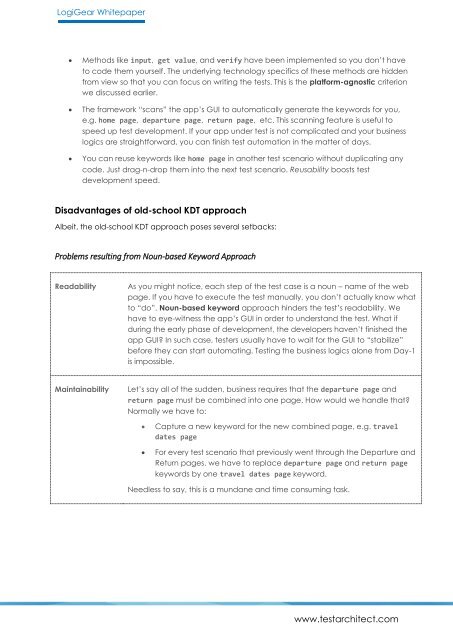The Evolution of Keyword Driven Testing
You also want an ePaper? Increase the reach of your titles
YUMPU automatically turns print PDFs into web optimized ePapers that Google loves.
LogiGear Whitepaper<br />
<br />
<br />
<br />
Methods like input, get value, and verify have been implemented so you don’t have<br />
to code them yourself. <strong>The</strong> underlying technology specifics <strong>of</strong> these methods are hidden<br />
from view so that you can focus on writing the tests. This is the platform-agnostic criterion<br />
we discussed earlier.<br />
<strong>The</strong> framework “scans” the app’s GUI to automatically generate the keywords for you,<br />
e.g. home page, departure page, return page, etc. This scanning feature is useful to<br />
speed up test development. If your app under test is not complicated and your business<br />
logics are straightforward, you can finish test automation in the matter <strong>of</strong> days.<br />
You can reuse keywords like home page in another test scenario without duplicating any<br />
code. Just drag-n-drop them into the next test scenario. Reusability boosts test<br />
development speed.<br />
Disadvantages <strong>of</strong> old-school KDT approach<br />
Albeit, the old-school KDT approach poses several setbacks:<br />
Problems resulting from Noun-based <strong>Keyword</strong> Approach<br />
Readability<br />
As you might notice, each step <strong>of</strong> the test case is a noun – name <strong>of</strong> the web<br />
page. If you have to execute the test manually, you don’t actually know what<br />
to “do”. Noun-based keyword approach hinders the test’s readability. We<br />
have to eye-witness the app’s GUI in order to understand the test. What if<br />
during the early phase <strong>of</strong> development, the developers haven’t finished the<br />
app GUI? In such case, testers usually have to wait for the GUI to “stabilize”<br />
before they can start automating. <strong>Testing</strong> the business logics alone from Day-1<br />
is impossible.<br />
Maintainability<br />
Let’s say all <strong>of</strong> the sudden, business requires that the departure page and<br />
return page must be combined into one page. How would we handle that?<br />
Normally we have to:<br />
<br />
<br />
Capture a new keyword for the new combined page, e.g. travel<br />
dates page<br />
For every test scenario that previously went through the Departure and<br />
Return pages, we have to replace departure page and return page<br />
keywords by one travel dates page keyword.<br />
Needless to say, this is a mundane and time consuming task.<br />
www.testarchitect.com


